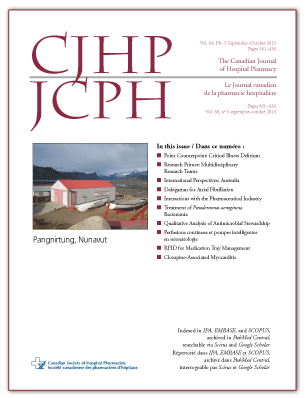Utilization of Dabigatran for Atrial Fibrillation at 3 Tertiary Care Centres
DOI:
https://doi.org/10.4212/cjhp.v68i5.1483Keywords:
arrhythmia, novel oral anticoagulants, drug use evaluation, hospital prescribing, arythmie, nouveaux anticoagulants oraux, évaluation de l’utilisation des médicaments, prescription en milieu hospitalierAbstract
ABSTRACT
Background: The outpatient management of stroke prevention for patients with atrial fibrillation has recently been published and provides insight into the benefits and risks of the new direct-acting oral anti -coagulants. However, real-world use of these agents for hospital inpatients requires additional study.
Objective: To determine prescribing patterns for dabigatran at 3 Canadian hospitals, specifically adherence with the hospitals’ prescribing restriction limiting dabigatran to patients with nonvalvular atrial fibrillation and creatinine clearance above 30 mL/min (primary outcome) and assessment of age-related prescribing, prescribing of medications with defined contraindications or potential for interaction when given concurrently with dabigatran, and use of risk stratification tools (secondary outcomes).
Methods: A retrospective chart review of patients for whom dabigatran was prescribed from August to October 2011 was performed at 3 hospitals in Toronto, Ontario. Descriptive statistics were used for all outcomes assessed.
Results: Overall, dabigatran was prescribed for 69 inpatients, of whom 16 (23%) were new users (dabigatran initiated during hospital admission) and 53 (77%) were prior users (dabigatran prescribed before admission to hospital). Fifty-eight patients (84%; 14 new users and 44 prior users) received dabigatran according to the hospitals’ prescribing restriction. For the remaining 11 patients, dabigatran therapy did not meet prescribing restrictions for use because of valvular disease or presence of prosthetic valve (10 patients [14% of the total sample]) and impaired renal function (1 patient [1%]). Among those whose dabigatran therapy met the prescribing restrictions for use, amiodarone and acetylsalicylic acid were the most common concurrently prescribed medications (17 patients [29%] and 14 patients [24%], respectively). Stroke and bleeding risk were documented for only 27 patients (47%) and 10 patients (17%), respectively.
Conclusion: At the study hospitals, dabigatran was appropriately prescribed for the indication of nonvalvular atrial fibrillation in patients without renal impairment in most cases. However, greater consideration of cardiac history including valvular disease and presence of prosthetic valves), drug interactions, and documentation of risks and benefits is warranted. These research findings highlight the importance of and opportunity for pharmacist review and involvement in assessment and selection of patients with indications for anticoagulant therapy, particularly when agents are new to the market.
RÉSUMÉ
Contexte : La publication récente sur la prévention des accidents vasculaires cérébraux (AVC) chez les patients externes atteints de fibrillation auriculaire permet de mieux comprendre les avantages et les risques des nouveaux anticoagulants oraux directs. Cependant, il est nécessaire de faire de plus amples études sur l’utilisation de ces agents en situation réelle chez les patients hospitalisés.
Objectif : Déterminer les habitudes de prescription de dabigatran dans trois hôpitaux canadiens, particulièrement en ce qui a trait au respect des restrictions de prescription en vigueur dans les hôpitaux qui limitent le dabigatran aux patients souffrants de fibrillation auriculaire non valvulaire et présentant une clairance de la créatinine supérieure à 30 mL/min (principal paramètre d’évaluation) et à l’évaluation de la prescription en fonction de l’âge du patient, de la prescription de médicaments avec des contre-indications précises ou un potentiel d’interactions médicamenteuses lorsqu’ils sont administrés en concomitance avec du dabigatran et de l’emploi d’outils de stratification du risque (paramètres d’évaluation secondaires).
Méthodes : Une analyse rétrospective des dossiers médicaux des patients à qui on avait prescrit du dabigatran entre août et octobre 2011 a été menée dans trois centres hospitaliers de Toronto en Ontario. Des statistiques descriptives ont été employées pour tous les paramètres analysés.
Résultats : Dans l’ensemble, on a prescrit du dabigatran à 69 patients hospitalisés. Parmi eux, 16 (23 %) n’en avaient jamais reçu (traitement amorcé pendant l’hospitalisation) et 53 (77 %) en avaient déjà reçu (dabigatran prescrit avant l’hospitalisation). Cinquante-huit patients (84 %; 14 n’en ayant jamais reçu et 44 en ayant déjà reçu) ont reçu du dabigatran selon les restrictions de prescription en vigueur dans les hôpitaux. Pour les 11 patients restants, le traitement par dabigatran ne répondait pas aux restrictions d’utilisation pour cause de valvulopathie ou de présence d’une prothèse valvulaire (10 patients [14 % de l’échantillon total]) ou d’insuffisance rénale (1 patient [1 %]). Au sein du groupe de patients pour lesquels les restrictions d’utilisation ont été respectées,l’amiodarone et l’acide acétylsalicylique étaient les médicaments les plus souvent coprescrits (respectivement, 17 patients [29 %] et 14 patients [24 %]). Le risque d’AVC et d’hémorragie n’était consigné respectivement que pour 27 patients (47 %) et 10 patients (17 %).
Conclusion : Dans les hôpitaux de l’étude, le dabigatran était habituellement prescrit de façon appropriée pour l’indication de fibrillation auricu - laire non valvulaire chez des patients ne présentant pas d’insuffisance rénale. Cependant, il est justifié de tenir davantage compte des antécédents cardiaques (notamment les valvulopathies et la présence de prothèses valvulaire), des interactions médicamenteuses ainsi que de la consignation des risques et des avantages. Ces données mettent en relief l’importance et la possibilité de la participation du pharmacien à l’évaluation et à la sélection des patients ayant des indications pour un traitement par anticoagulant ainsi que de son analyse de ces cas, particulièrement lorsque les médicaments sont nouveaux sur le marché.
Downloads
Published
Issue
Section
License
Copyright © Canadian Society of Healthcare-Systems Pharmacy.
After publication of a manuscript in the CJHP, the authors of the manuscript must obtain written permission from the CSHP (publications@cshp.ca) before reproducing any text, figures, tables, or illustrations from the work in future works of their own. If a submitted manuscript is declined for publication in the CJHP, all said rights shall revert to the authors. Please note that any forms (e.g., preprinted orders and patient intake forms) used by a specific hospital or other health care facility and included as illustrative material with a manuscript are exempt from this copyright transfer. The CJHP will require a letter from the hospital or health care facility granting permission to publish the document(s).










